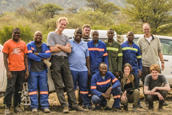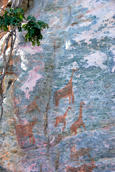Disapperance of a Lake
Freie Universität Berlin Receives Grants from German Research Foundation for Earth Science Project in Botswana
№ 268/2015 from Sep 14, 2015
Earth scientists Prof. Dr. Frank Riedel and Dr. Kai Hartmann from Freie Universität are studying environmental and climate changes over the past millennia in Tsodilo Hills, Botswana, which has been a UNESCO World Heritage Site since 2001. Their research is focusing on the emergence, existence, and disappearance of a lake in the area. The German Research Foundation (DFG) approved a grant of 20,000 euros for a period of 18 months. The researchers plan to complete a pilot study by the end of 2016, which depending on the results, could later be developed into an extensive research project.
"We believe that we can submit a renewal proposal to the DFG next spring because our field work, which was concluded at the beginning of September, was very successful and we are getting very interesting results already," said Frank Riedel, a professor of paleontology at Freie Universität.
The scientists from Freie Universität are working in Botswana with Prof. Dr. Elisha Shemang from the Botswana International University of Science and Technology (BIUST) and Gertrud Matsviri from National Monuments and Museum of Botswana. The scientists and their students are working from different perspectives: While Kai Hartmann and Elisha Shemang are reconstructing the physical conditions such as the size of the lake, the water balance, tectonics and sediment transport by means of remote sensing, sediment analysis, and geophysics (including ground-penetrating radar, DGPS, and seismology), Frank Riedel is investigating the biological responses to precipitation and changes in runoff. A great deal of information, including precipitation patterns and the presence of parasites such as schistosomiasis that are dangerous for humans, can be derived from fossil snails.
An interesting aspect for the research is the fact that the ancestors of the current residents of the region around Tsodilo Hills, the San or Bushmen, as the residents call themselves, lived in the region for the past 100,000 years. Part of their history, including changes in the local environment, is depicted in approximately 4,500 rock paintings in the Tsodilo Hills.
The project is part of a 15-year long series of DFG and BMBF projects dealing with the transformation of Asian and African monsoons that Riedel and Hartmann are working on. Dr. Rik Tjallingii from Geoforschungszentrum Potsdam and Prof. Dr. Frank Lehmkuhl from the Rheinisch-Westfälische Technische Hochschule (RWTH) Aachen are also involved in the project.
Press Photos
The Kalahari research team from BIUST and Freie Universität Berlin in the former lake basin of the Tsodilo Hills during field work in August 2015 (from left to right, standing: B. Kgosidntsi; C. D. Ramotoroko; Frank Riedel; P. Tlale; Robert Wiese; J. Kaavera; A. Kandjou; B. Nthaba; Kai Hartmann; sitting: K. Kavindama; Venise Bayer; Lasse Riedel)
Credit: Kai Hartmann, 08/2015
The rock paintings from the Paleolithic period have made the Tsodilo Hills famous. Today UNESCO is watching over this World Heritage Site.
Credit: Kai Hartmann, 05/2013
The photos may be downloaded by members of the media and used free of charge in the context of this press release, provided that due credit is given to the photographer.
Further Information
- Prof. Dr. Frank Riedel, Department of Earth Sciences, Freie Universität Berlin, Tel.: +49 30 838-70283, Email: paleobio@zedat.fu-berlin.de
- Dr. Kai Hartmann, Department of Earth Sciences, Freie Universität Berlin, Tel.: +49 30 838-70436, Email: kai.hartmann@fu-berlin.de


